In a conversation with a fellow (not embroidery) blogger the other day, we were discussing trendy blogging and social media topics. We got on the subject of how words are used these days, and I listed off a few pet peeves.
For example, I don’t like the prevailing use of verbs as nouns and nouns as verbs. I gave a few examples: fail as a noun, adult as a verb, art as a verb.
I have to pay bills. I guess it’s time to adult.
I’m going to art all day long today!
I had a big adulting fail yesterday, when I slept till noon and missed work.
Cake fail. Cooking fail. Building fail.
It rubs me the wrong way.
As the topic progressed, I was challenged to write an article about an “embroidery fail,” and to use the term “fail” the way I don’t like using it.
(I’m only explaining this whole backstory so that you know why the title of today’s article is what it is!)
And just to clarify – I know that there is a history of “fail” being used as a noun in the academic sense. The way it’s used today, though, is just as a shortened version of failure.
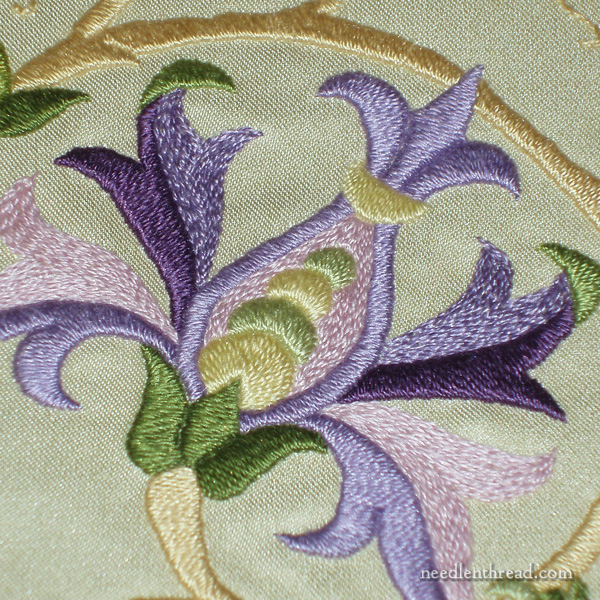
That’s not the only reason I don’t like the whole “focus on the fail” thing.
The main reason I don’t like it is that I think that what people consider a failure is not necessarily a failure.
Often, it’s a valiant effort that didn’t achieve the desired results.
But does that make it a failure?
I don’t think so.
In most situations in life, mistakes and failures are opportunities. They’re opportunities to learn. They’re opportunities to adjust the outcome to something unexpected or unplanned.
They might involved disappointment. They might be frustrating. But they don’t have to drag us down. And we don’t have to focus on them as “failures” as such.
Especially in needlework (which, in the Grand Scheme of Things, is not really a primal aspect of life), “failures” and “mistakes” are not life-shattering.
It is only thread. It is only fabric.
And a perceived mistake or failure can be fixed or forsaken. Life will still go on.
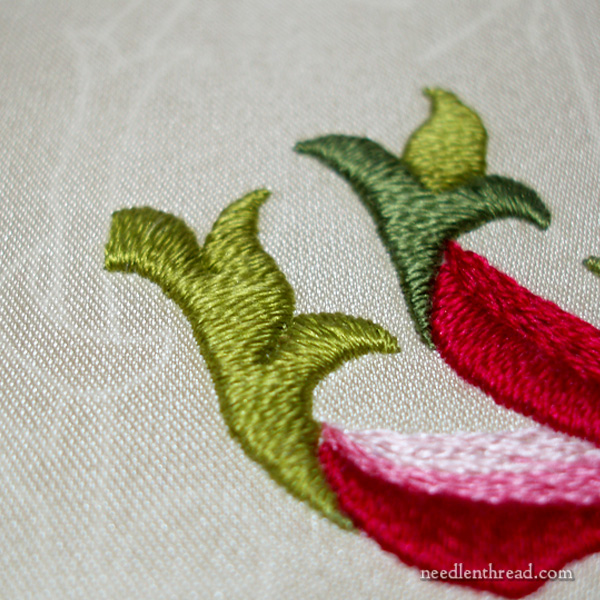
I have plenty of embroidery failures under my belt.
By failures, I mean the things I’ve done wrong with needle and thread – the projects that I started that didn’t turn out the way I wanted or hoped – or that didn’t turn out at all! Things that fell apart because I chose the wrong materials. Stitching that looked less than lovely because I didn’t have the knowledge or skill to pull it off. Bad choices in threads or fabrics or finishing materials. Careless cuts into fabric. Spills on embroidery! Spot damage! Color running!
Learning embroidery – or any type of needlework, art, craft, hobby – is a journey.
No one starts at Level Perfect. And no one (that I know of, anyway) ever achieves Level Perfect. We’re human. We make mistakes. And it’s ok.
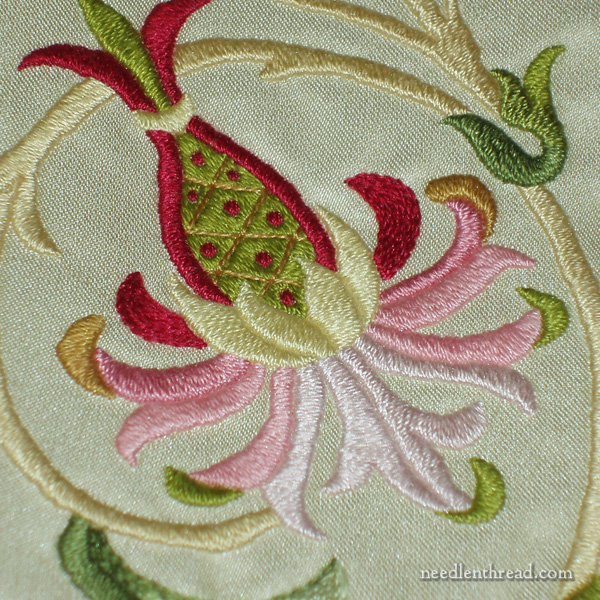
But, back to the topic and terminology. The Embroidery Fail that sticks in my head the most is this project pictured here.
If you have been hanging around Needle ‘n Thread since practically its beginning, you’ve seen this before.
I took a stole that was embroidered in the 1800’s and I set out to re-create it.
In the ecclesiastical sense, a stole is a long strip of material that passes behind the neck, over the shoulders, and down the front of a priest. Each side usually mirrors the other, so it’s essentially two more or less identical strips sewn together where they meet behind the neck.
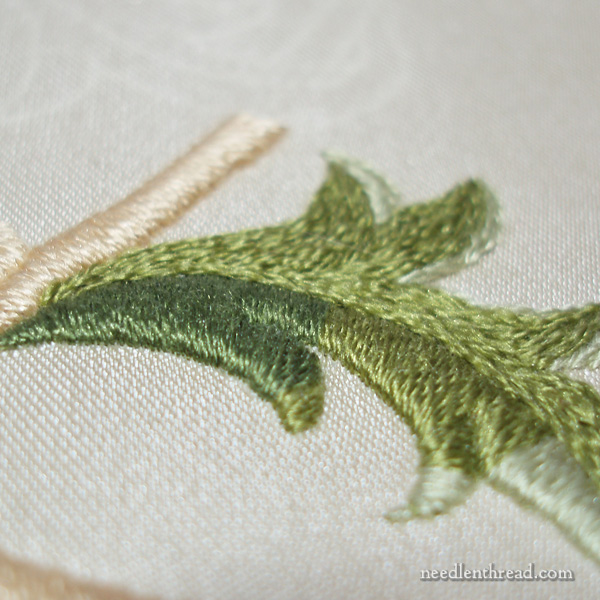
I copied the design by tracing it as best and as carefully as I could, and then by filling in with sketching where necessary. I made some modifications and then cleaned it up into a usable pattern.
I selected a beautiful Italian silk satin as the ground fabric. It was the nicest silk I’d ever seen and that I’ve ever seen since, and it was such a pleasure to stitch on! It was like … butter. Soft, pale, golden butter. What a fabric! I wish I had bought yards and yards and yards and yards of it! But even back then, it was $100/yard! And I didn’t really understand the value of what I had, anyway. I just knew I liked it!
For thread, I made the two-hour journey to the closest needlework shop available at the time and I color matched the back of the threads on the old stole with Soie d’Alger.
I invested in a boatload of that thread.
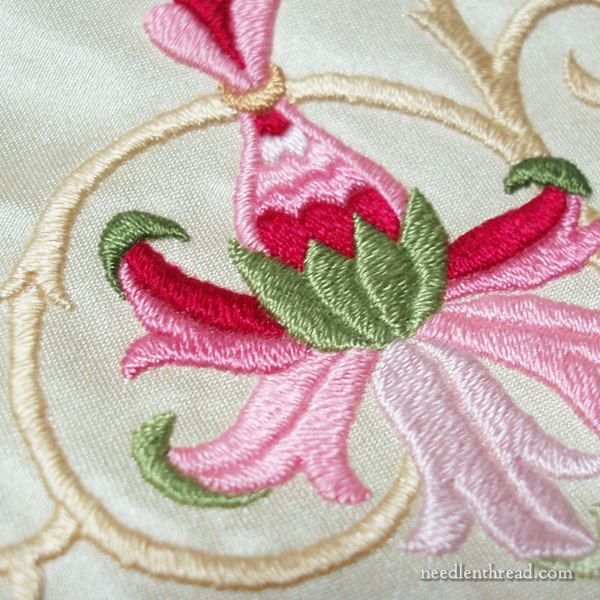
I didn’t really know threads the way I know them now, and the same abundance of threads was not as readily available. We enjoy such a rich profusion of threads these days!
If I knew then what I know now, I would have mixed up the types of silks. I would have used Soie de Paris, Soie Perlee, Soie Ovale, and Soie d’Alger!
The original stole was all satin stitch and split stitch, though, so I was safe with Soie d’Alger. But oh! If I were doing this project now! How I would change it!

It was a lot of satin stitching, that’s for sure.
What happened with the project?
I finished one side of the stole. If I ever get it out of storage, I will probably stretch it and frame it.
I was well along in the second half when we had company one night – a friend, her three year old, and her mother. She wanted me to show the embroidery to her mom. I hesitated because the three year old was there and was very active… and also eating M&M’s.
But they begged, and my ego got the better of me. I wanted to show it off! And perhaps therein lies the greatest part of this “fail.”
I took it out.
It all happened in slow motion. The embroidery came out, the three year old lunged, the gooey, slobbery M&M-hands stretched forth … and … blyck.
That ended that project. I just couldn’t face the clean up. Actually, I did try to clean it up, but then I couldn’t face cleaning up the failed clean-up.
I admit I was annoyed. The thread and fabric could be replaced, but the time and effort – not so much.
But that’s ok. I wouldn’t ruin a friendship over thread and fabric.
This is The Thing, though:
In a sense, the whole event saved the project.
After that, I learned so much more about this type of embroidery. I realize now that the stole would never have turned out the way I expected it to. It would have been puckered. There was no backing fabric behind the embroidery. I didn’t know how to finish this type of embroidery in a way to ensure longevity. My sewing skills were nil. There are so many little things that weren’t in place yet for that project.
I’ve always had it in my mind to work this project again. Now if I do it, I can do it with much greater confidence, with a plethora of wondrous threads, and with (I think) greater skill and better design sense, too.
I’m not sure I could ever find that fabric again, though. *Sigh*
Anyway, that’s probably the biggest project that sticks in my mind as a regretful end. I learned so much from it, though, that I don’t really consider it a waste.
As for fails, there are so many more. But I never really look at them that way.
And I hope you don’t, either!







The one that really bothers me is “to gift” as a verb. “She gifted me a beautifully embroidered stole.”
And I don’t see any M&M stains on that work. Looks gorgeous to me.
🙂 The M&M goo was on the other half.
On the bright side, it didn’t deter me from liking M&Ms!
I’m with you, Mary. Nouns are nouns and verbs and verbs, ever they shall be. I hear that crap all the time on TV, or read it in articles on the internet, and it infuriates me. God help my family members if they should be silly enough to try it.
P.S. Sorry about your stole, but another pet peeve of mine is parents who don’t control their little children.
I am with you all the way! Using verbs as nouns and vice versa is a pet peeve of mine, also. It drives me crazy!
I also agree with you that parents should not allow their children to run amuck and misbehave in a manner which results in the destruction of someone else’s property.
Oh, how I love your blog today! Thank you for reminding us that, really, nothing in life is perfect. And that our failures are tremendous learning opportunities pushing us forward. It is so easy these days to beat ourselves up for less than perfect stitching, or baking, or dealing with difficult relatives, or whatever. It is enough for us to do the best we can, as much as we can. In the future, when I am disappointed in myself, I will think of your stole–half finished and stained–and move on down the road to the next challenge. Thank you, Mary!
Mary, you may view this as a “fail”, but you were working on this project when I found your blog. While I had been a cross stitcher years previously, the beauty of your work lead me back to embroidery, and I’ve gone on to learn surface embroidery, pulled work, Hardanger, and blackwork. Thank you!
❤️❤️
Dear Mary, Thank you for your proper usage of the English language. I, too, have a problem with verbs used as nouns. I don’t care if there is some obscure historic precedent for such usage. It’s just wrong! (Rant over).
Coincidentally, I have recently unearthed a project that I started maybe twenty years ago. Everything was going smoothly till I decided a Tudor Rose would be the final element of a banner I had designed. Half way through, I decided I didn’t like it, stopped and put it away. On taking out again, I wondered why I simply didn’t un-pick it and redesign with a dog-rose instead. Simple. Why wasn’t that obvious twenty years ago. Oh, the objectivity that comes with the of the passage of time!
Mary, this delightful treatise on failure resonates with me in so many ways I had to take a moment to thank you for it. I definitely agree with you that the “nounification” of verbs and the “verbification” of nouns is an alarming trend for those of us who like to use precise language. Also, I am always so sad when words are taken away from me and used exclusively to apply to something new when there are no perfect words waiting in the wings to fill the gap left in our language. There has never been another word I’ve heard that can really express what we used to mean when we said something was “gay” before it came to mean what it does now. You can come close, but happy, lighthearted, cheerful, bright and all the other synonyms listed in the thesaurus just don’t convey quite the same meaning unless you use several together. I would previously have used that word to describe a few of my embroidered towels from your Spring collection…and happily, it’s almost time to put those out!
Now can we talk about the difference between a “button-down shirt,” which is a very specific type of shirt with a collar that buttons down to the body of the shirt and a “button up” garment, which is any shirt or blouse that has an open front that closes with buttons and buttonholes? Everywhere lately I see the phrase “button down shirt” applied to any garment that has buttons and buttonholes on the center front for access. Whew, got that off my chest! Thanks for the opportunity!
Sticklers unite!
Dear Mary,
Thank you for this thoughtful and meaningful post! You may never know how much your words touch others, but today, they spoke volumes to me
I very much appreciate your knowledge and instruction of embroidery that you so selflessly offer. I also appreciate your thoughts and views on life and language. Today, however, I mostly appreciate your inspiration!
I hope your day and your life are blessed. Thanks, again.
This story comes at just the right time for me! I absolutely bit off more than I could chew! Bought the most expensive bridal silk-satin available, and a boatload of Au Ver a Soie Gobelins. After a false start, I’m almost finished the beta version. It doesn’t look the way I wanted it to, but I learned a lot in the process about how to design a project, materials, stitches, etc. I learned the same lesson I have to learn every time I start a project of *any* kind — no shortcuts. Measure twice, cut once. Have a plan and *write it down*.
I’m going to finish this beta and totally codify everything I learned.
I didn’t *fail*. I *succeeded* in figuring out what I need to do for the final version. It was a successful field training exercise.
Mary, your words about failed projects aren’t new, but they definitely bear repetition. What bothers me most about some of these projects, in whatever medium, is what to do with them! It seems so wasteful to just throw them out. Some of them are worth keeping around for reference, but others just take up space. I’m curious what you and other readers choose to do with them.
Funny, I was just thinking of this project the other day and wondering if you had ever finished it! I remember when I first saw it I was in awe, I guess that is why it stuck in my mind. Such beautiful stitching! I do admire your philosophical way of looking at…well, what happened to it! I really hope you undertake reproducing it again, I would love to watch the journey!
When I used to stitch in round robins, we referred to mistakes as creative design decisions — no one else was the wiser.
And a quilting friend told me that sometimes what we look at as a mistake could turn into something that others really like.
It’s all pretty much subjective.
Hi Mary, thank you for writing this article.
Oh Mary! Thank you for the perfectly honest “fail” article. If anyone has a passion for embroidery, knitting, sewing, painting, etc. they have been where you were. I also don`t look at the fail but with new eyes, I learned something. It means I`ve grown. Thank you for all you do for us.
Fondly,
Karole in bluebonets
I loved reading today’s blog – so true and so real!
“No one starts at Level Perfect. And no one (that I know of, anyway) ever achieves Level Perfect. We’re human. We make mistakes. And it’s ok.”
Part of why we never reach Level Perfect is because as we progress and learn we move Level Perfect forward – as we grow so do our demands and our expectations.
Language is an ever changing tool. Who uses Latin or Old English in their daily lives today? Does anyone understand the long S rules any more? The letters i and u are fairly new introductions. The Oxford comma is a whole yay or nay subject, yet lawsuits have been won or lost on its use or lack thereof. Even using a double space between sentences is coming up for debate now.
While the use of verbs as nouns and nouns as verbs is jarring, what bothers me more is the growing habit of shortening words to the one syllable (derm for dermatologist, bro for brother, etc). Humans have grown many lovely expressive languages from our ancient days of grunts and growls, and now seem to be returning to single syllable language. And then there’s acronyms and emojis and their multiple or unexpected meanings. Harumph! I think here’s where I should also insert a “get off my lawn!” ?
Anyway, back to the subject… I agree with you that failures are not a waste if you learn from them. It’s difficult to keep that in mind while pondering the materials, the money spent on them, the time, and the energy used though. Didn’t Thomas Edison supposedly say something about finding thousands of ways *not* to make a light bulb before he got one that worked?
Sorry about the damage to the stole. It would have been gorgeous had it not been for the puckering issue. How many years did it take to realize that accident probably saved you many hours of work only to be disappointed by the result?
What a sad story! But I hear you, regarding lessons learned. As for silk threads, this sentence resonated: “If I knew then what I know now, I would have mixed up the types of silks. I would have used Soie de Paris, Soie Perlee, Soie Ovale, and Soie d’Alger!” I want to learn this, too! I keep buying those enticing ‘Ensemble de Soie’ and ‘Discovery Packs’ from Hoop & Frame and the French Needle, but then I have no idea what to do with them. I hope that the upcoming Jacobean project, and perhaps other Needle ‘n Thread offerings will help me learn. Thank you.
Your story reminded me of a Jane Nicholas project that I had nearly finished when I was a eating a chocolate. Yes I stained the background fabric. Luckily I could add an extra stump work leaf. A learning experience
Thank you Mary! I am writing on Sunday’s sermon, and will quote your blog. The subject is The Struggling Faith, and the text is the woman anointing Jesus’ head causing some to quarrel with her. Life is a learning process. Blessings!
🙂 Thanks, Erika!
Yes, learning experiences…. The stole is beautiful! I do hope you will finish the completed section as a framed piece. It’s too lovely to be tucked away. It could be a gift to your new house—both refashioned.
Ooooh! I thought of it for the studio, but yes, I will have a very narrow wall at home that I might put it on. Ah! We shall see!
My pet peeve lately has been learnings — Reflect on your learnings — all the sighs on that one! Perhaps we could say “reflect on what you have learned” or “reflect on the insights you had from these lessons” I know language is ever changing, but when we have perfectly usable and meaningful words, why make up something?
Oh wow! I haven’t heard that one! Ut oh. Now I bet I’m going to hear it everywhere……!!!! LOL!